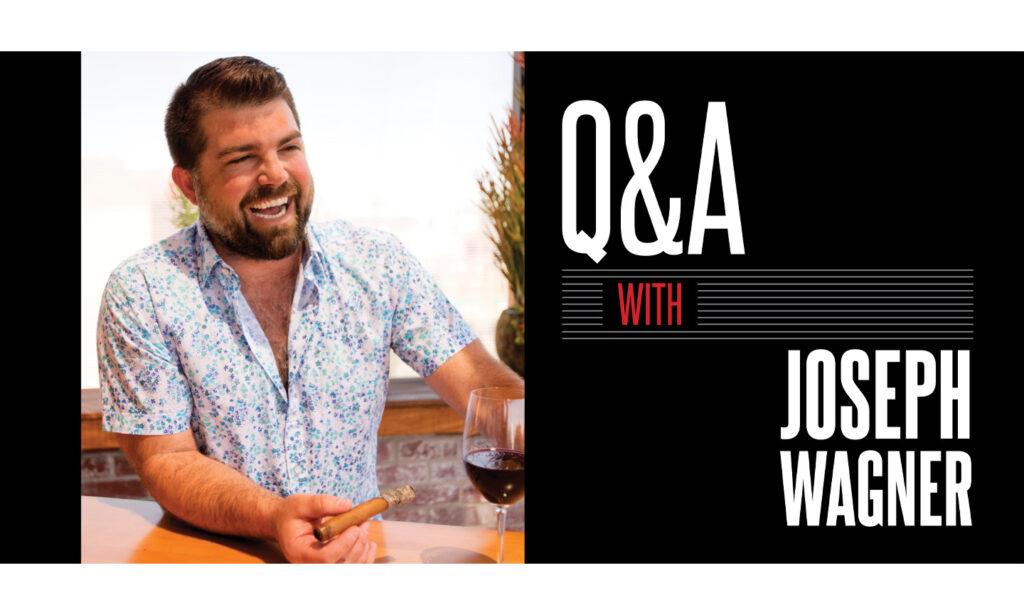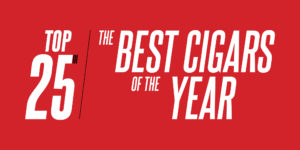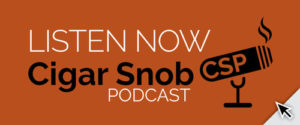Joseph Wagner has made a name for himself by consistently bringing quality pinot noirs to market since he followed in the footsteps of four generations of Napa growers and winemakers. He’s taken the teachings of his legendary father, Chuck Wagner of Caymus, and paid homage to the land that has brought his family and droves of wine lovers so much joy. Along the way, he developed an acute affinity for fine cigars, even going as far as blending a couple of wine-friendly smokes for friends and family.
Let’s start with your family. Anyone who drinks Napa cabs knows the Wagner name but what was that like growing up? Did you know what your family meant to the wine business?
In my youth it was much more of an agricultural focus. My family didn’t make wine under the Caymus label and during those years and Napa Valley wasn’t really as world-renowned as it is today. Napa was a farming community and we were a farming family. During the 80s and 90s is when Napa really started to see its cabs hit the world stage and people take note of them. But along with that, the rise in awareness of luxury wine and great cabernets coming out of Napa Valley elevated the whole area. I grew up working in the vineyards. Every once in a while when I got into my mid-teens, they’d let me go in the winery and work in there. So learning from the ground up. My dad taught me a lot especially in the farming side of things and of course in winemaking, but I think the most important thing he taught me was to always push the limit, always try new things and always evolve. I think to this day, any wine that I’ve ever made and he’s tasted, he’s never said it was a perfect wine, there’s always something better you can do. And that’s kind of what continues to drive us today is that innovation and trying to create something better. It could be something small or something major in our process and grape growing and winemaking. So I think that that’s the most important part. But it was a different world here. I mean, yeah, it’s, it’s beautiful out here in Napa. And you know, as the dotcom boom came and more people came with a lot more money, the beauty and elegance of the place elevated, which is a great thing but overall it still is an agricultural community and that’s where it is in my heart and that’s where I’m raising my kids.
You can see that your sort of affinity for the farming and agricultural component, it comes through in your products. You use it in your naming and you sometimes have quotes in there about farming and the land.
What’s interesting about wine is I really can’t think of any other product or very few other products that can capture a sense of time and place and hold onto it for years to come. And interestingly cigars are similar to wine in that sense. Cigars are one of the only other products I can think of that you can go back and let’s say find a Cuban cigar from 1962 and experience to some degree the year that cigar was made. If you want to call it a vintage of cigar, you’re going to experience that year in that place. And I think that having this intrinsic tie to the land between wine and cigars is one of the most unique elements of it being a product. And I think whether we don’t think about it, or it’s a subconscious thing that ties us as humans all together. Farming is as you mentioned, it was Daniel Webster that stated it: “Farming is the foundation of human civilization.” If you really think about it, this is very true. Without farming you are a nomad, you’re walking around scavenging for berries and food. So farming really has you literally put down roots, and having a product that brings people around a table and enjoy life and brings up the communication like wine. Having that tie to the ground is just something that inherently we really appreciate as humans.
So let’s dive into cigars. When did you first get introduced to cigars?
Growing up, my family would have friends over and inevitably we would end up on the porch. My dad and his friends would always have a cigar. Typically, my dad would have it with port. And that’s where it all started. He taught me how to actually taste the cigar rather than just breathe it in and cough up a lung. And so that’s kind of how it began. And then as I grew up and I got into making wine, I started smoking more cigars. Part of it was I would travel to the central coast where we grow grapes for Clark and Telephone and the Las Alturas vineyard. It’s about a six-hour drive from here, so most of the time, I leave really early in the morning, get down there and do my rounds. And then stay the night, hit the next county and then come back late that second night. Inevitably I’d be tired and driving so I’d turned the music way up and smoke a cigar while I was driving to keep me awake. And then as I continued to smoke more cigars I would learn more about them. Every harvest night, at the end of the day, it could be nine or 10pm, I would go back to my office and do my paperwork, just trying to catch up and get ready for the next day. And I’d have a cigar every time I was doing that. During harvest I’d go through dozens of cigars, if not more. It got to the point where around 2010 I wanted to start looking at making our own cigars. And so I ended up going through about four cigars a night during that period and focused more on tasting than just smoking. So it was a great learning experience and I was able to take my notes and understand what I really liked about certain cigars. At this point is when I started to evolve the idea of what it would take to create the perfect cigar for a wine pairing. Because oftentimes certain cigars, a Maduro for example, will overpower some wines and you want something a little bit lighter, a little creamier. And so that’s what we really started focusing on when we started to blend our own cigars. That was a fun process, but that’s what really got me into it. It started with my dad as a kid and then just kind of taking that and rolling with it. But you know, cigars are a great product; it’s a great thing to enjoy. It doesn’t need to be just for celebrations.
Agreed! The car ride story you tell is perfect; there are so many guys that smoke cigars like that. It’s a late night after work and the cigar gets them home safely and relaxed. My favorite however is what you mentioned about doing paperwork. I tell people all the time because we work while smoking cigars, obviously daily. When you’re doing work, and you’ve got a cigar, man it makes that time a little more pleasurable than it otherwise would be.
Way more pleasurable! Yeah. You’re like, okay, here’s my relaxation while I get everything prepared for tomorrow and it really is a good just kind of wind down moment. Yep, paperwork and cigars are better than paperwork and wine! [laughing]
Can we dig just a little deeper into when you went down the path of creating your own cigar brand? I know there isn’t a product that people can buy but I’d still like to talk about it. We don’t often interview winemakers who’ve tried their hand at cigar making. How did that take place?
I got in contact with somebody I met through the wine business and we started playing with different blends and we eventually settled on the first blend that we just call the Habano. Then one with a Connecticut wrapper; two different styles of cigars but both complementary to wine. And this was really just for personal family use and enjoying with friends in business. And at some point we thought we’d like to bring it out into the marketplace and see what people think about it. However, wine is our business. And tobacco is something that’s a completely different ballgame.
But we’re learning about it. The process was just dialing in blends, and this probably went over for a two-year period, we were in no rush. We’d adjust little things and adjust big things and eventually settled on these two blends. They’re made down in the Dominican but they also work with Nicaraguan and a little bit of Mexican tobacco.
Does it have a name?
We call it Avrae. The tube it is packaged in has a similarity to the wax dip that we have on our Belle Glos, which was going to be the intention. We do a light box press on the Habano, and then the Connecticut is round. Both are individually packaged and they’re great little wine cigars. So that was the process, and the reason for it was to create something that really did pair well with pinot noir in particular. And I’m really happy with how it turned out.
Tell us a little bit about Copper Cane. Why you started it? Why the name? I like the name, I think it’s a cool reference but maybe most people won’t get it.
People ask me “Was that name chosen because that’s what your dad beat you with as a child or something?” No, no, there’s a whole story to it. Allow me a brief history here; my family actually immigrated to Napa in the 1850s from Alsace. They got into growing grapes and making wine but they were unfortunately shut down by Prohibition, so they resorted to prunes and walnuts. Then in the late 1960s they weren’t making ends meet and decided to try their hand in the wine business again. So in 1972 they had their inaugural vintage of Caymus vineyards. Within a few years they realized cabernet was king, it was the right fit for the land here. And they started to kind of shed off the other varietals they were producing.
Now fast forward a few decades into the late 90s. I got involved and started learning about the business, starting in vineyards, then getting into winemaking, and then learned all the other aspects of it. I started with pinot noir. It was the first vineyard I planted and we had fruit coming off of it within a few years, and had no plans for that fruit. I just took it in the corner of a cellar and started playing with it, asked my dad a lot of questions. I tried to learn about it as much as I could. It’s a very different variety than cabernet. It’s a thin skinned variety that tends to take that sense of time and place to an extreme, which can be a positive and a negative. The positive is that it is the most expressive of that site in place and time, but also it tends to show its flaws much easier. So I realized the cabernet focus was not going to be how we approach pinot noir, but I’d also say there was a time back into the 70s and 80s when people were trying to emulate Bordeaux with Napa cabernets. Bordeaux was looked at as the benchmark and so winemakers were trying to make wines that tasted like that. And eventually Napa cabernet decided it had its own unique style, as it should. That became the beginning of Napa Valley cabernet and this kind of cult style that we look at. It was no different with pinot noir, just a few decades later. So I wanted to express to the fullest extent what Mother Nature gave us, and started to come up with my own processes and how to make these wines that are going to be more mouth-filling than your typical pinot noir, but still have grace and elegance with this beautiful acidity to carry the back end through. Inherently pinot noir doesn’t have a lot of structure. So you really need to rely upon the acidity to get it balanced.
I started Belle Glos first in 2001. Just a small side project before the movie Sideways hit. And from there, as you know, it was an uphill battle; I’ll say that it was hard to get American consumers to try out pinot noir at that time. But we were able to make some inroads and got some people in the restaurant world that really liked our wines and saw what we were doing. Then when Sideways hit, the world changed. So through that beginning of Belle Glos, we also created a brand that is now known as Meiomi. It’s no longer part of our portfolio, we sold it in 2015, but that one was intended to expose the general public to California Coastal pinot noir and it really did a fantastic job of that. So much so that it kind of changed the way that I look at how we should be operating in the wine business as far as how we get our wines out there and really focusing on restaurants getting these wines by the glass so people can enjoy them, try them and experience a number of different wines and styles. That’s what really created the beginnings of the Copper Cane philosophy when it came to what we wanted to bring out and that was really a philosophy of going off your palate to try wines and figure out what you enjoy. I don’t care if it’s Two Buck Chuck white zinfandel or a $2,000 burgundy. If you like it, you like it and that’s your palate and I’m glad you’re drinking wine so that at the end of the day, that is the most important thing.
When we started Copper Cane in 2014, we started with mostly pinot noirs, Belle Glos being one of them. We started with the Quilt cabernet shortly before that vintage with the 2013, then Elouan pinot noir, and later on the chardonnay focusing on Oregon. Then of course Böen being our most recent addition to the lineup which came in the wake of the sale of Meiomi in 2015.
So what Copper Cane stands for is a kind of foundational component to how we look at and how we make our wines. This is more about maturity of the grapes. So in the typical wine world we look at sugar levels or brix and you look at that and say okay, we’re going to pick at 25 or 26 brix of sugar. Well, the difference is every year, you might have a light crop or a heavy crop, the dynamics in the season, your sugar accumulation is not going to equate to the same amount of hang time you have for that fruit to be developing on the vine. So a light crop year with a lot of heat spikes, sugars are going to come quick, but you might not have that what we call physiological ripeness of the fruit, then in opposite years, the same is true. So we started looking at those physiological attributes, the seed and the maturity of the seed, I know that sounds odd, the flavors of the juice in the skin, of course, the texture coming out of the skin because that is really where all of those textures and color compounds come from. Then the vine itself, we want to see some elements of a kind of turning of the season. We want to see that base of the canopy going from green to yellow but most importantly we have these green vines, and as we go into ripening, which is probably going to occur in mid-July, we want to see the vines or canes move from green and succulent to a pale yellow color and eventually start as a copper color at the base and migrate all the way up to the tip. When we see that, which is actually called lignification, a fully lignified cane we have now seen that the vine has kind of purged itself of the green characters and therefore will purge itself of the green characters in the resulting wine. So that’s where the name copper cane comes from.
I love that. Maybe it’s a little geeky for some but I love that low-key way of referring to quality.
I mean, the core of it is consistency in quality and style and that’s how we’re able to achieve it. We may see variations from vintage to vintage on alcohol levels, not drastically, but we’re maintaining a consistent style and that’s what’s really most important to me. I love consistency in vintage to vintage wines.




